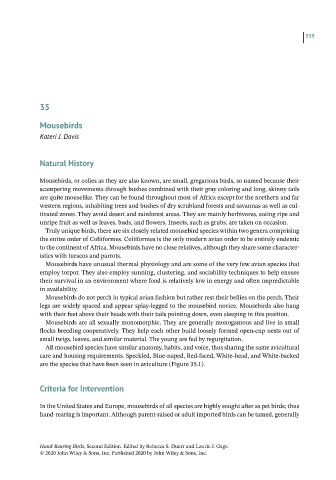Page 540 - Hand rearing birds second
P. 540
539
35
Mousebirds
Kateri J. Davis
Natural History
Mousebirds, or colies as they are also known, are small, gregarious birds, so named because their
scampering movements through bushes combined with their gray coloring and long, skinny tails
are quite mouselike. They can be found throughout most of Africa except for the northern and far
western regions, inhabiting trees and bushes of dry scrubland forests and savannas as well as cul-
tivated zones. They avoid desert and rainforest areas. They are mainly herbivores, eating ripe and
unripe fruit as well as leaves, buds, and flowers. Insects, such as grubs, are taken on occasion.
Truly unique birds, there are six closely related mousebird species within two genera comprising
the entire order of Coliiformes. Coliiformes is the only modern avian order to be entirely endemic
to the continent of Africa. Mousebirds have no close relatives, although they share some character-
istics with turacos and parrots.
Mousebirds have unusual thermal physiology and are some of the very few avian species that
employ torpor. They also employ sunning, clustering, and sociability techniques to help ensure
their survival in an environment where food is relatively low in energy and often unpredictable
in availability.
Mousebirds do not perch in typical avian fashion but rather rest their bellies on the perch. Their
legs are widely spaced and appear splay-legged to the mousebird novice. Mousebirds also hang
with their feet above their heads with their tails pointing down, even sleeping in this position.
Mousebirds are all sexually monomorphic. They are generally monogamous and live in small
flocks breeding cooperatively. They help each other build loosely formed open-cup nests out of
small twigs, leaves, and similar material. The young are fed by regurgitation.
All mousebird species have similar anatomy, habits, and voice, thus sharing the same avicultural
care and housing requirements. Speckled, Blue-naped, Red-faced, White-head, and White-backed
are the species that have been seen in aviculture (Figure 35.1).
Criteriafor Intervention
In the United States and Europe, mousebirds of all species are highly sought after as pet birds; thus
hand-rearing is important. Although parent-raised or adult imported birds can be tamed, generally
Hand-Rearing Birds, Second Edition. Edited by Rebecca S. Duerr and Laurie J. Gage.
© 2020 John Wiley & Sons, Inc. Published 2020 by John Wiley & Sons, Inc.

